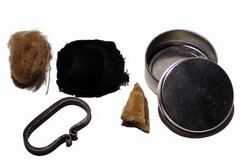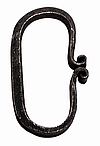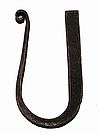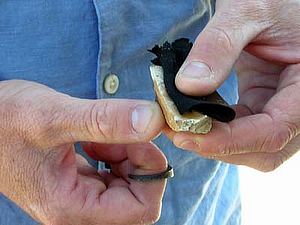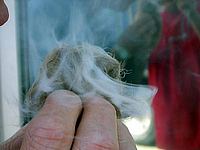I wrote this years ago, but it has been lost in the archives. I thought it would be good to put it out there again. -CL
There is something magical about making fire from materials other than the standard Bic lighter or Ohio Blue-Tips. Moreover, it is often a better method than matches.
The Flint

Flint isn’t really a single rock, it’s more like a loose family of rocks at about eight or so on the Mohs scale of hardness. Cherts and flints are multi-colored, depending on their chemical content, and vary in hardness.
I use Niagara chert because it’s easy to find in my area – several unglaciated areas have chert deposits that are easy to harvest. The ideal flint for striking a spark has a sharp, acute edge that will take a bite out of the steel. The flint sometimes needs to be “dressed,” or knapped with a hammer or other flint to get that proper edge. A round cobble of flint will not work until it is properly edged.
It is a common misconception that the flint particles make the spark. This is due to the average person seeing the little dark flint in a disposable lighter, and the steel wheel that does not wear, while the flint does. This is not true flint, but a compound of cerium and iron that burns when scratched.
The true flint itself does not spark. Rather, the high pressure exerted on the steel causes a small curl of steel to peel off and ignite. To understand why the steel ignites, bend a coat hanger over and over again in one spot. Soon it will be so hot you cannot touch it. That energy warms the metal. Now imagine putting all the force of your downward stroke into a microscopic flake of metal. Of course it burns!
The Steel
A good steel is made of a high-carbon tool steel. My favorite is W1, a water-quenched tool steel that I quench in oil to get it to the proper hardness. When oil-quenched, it is hard enough to resist the pressure of the flint, except for the small piece that ignites. A properly treated steel should give off thousands of sparks, if not millions, before being lost. You will certainly not wear one out. If the steel becomes too hot, it must be re-tempered before it can be used again.
The shape of the steel is a personal preference. C-steels, which are roughly the shape of a letter “C,” are most common. U-steels are often used by folks with larger hands who can’t get them comfortably in a C-steel. They are both used in the same manner.
The Char Cloth
You can make sparks all day without causing so much as a wisp of smoke if you are not giving your sparks a happy and fruitful ground upon which to light. The best material for such fire-starting is char cloth, which is simply linen or cotton cloth that has been burned in a low-oxygen environment (like the small tin in the illustration). A small hole poked in the top allows smoke and pressure to escape without the oxygen burning the cloth completely.
To make char cloth, pack a small airtight tin with linen or cotton patches about 2 inches square. Place the tin on some hot coals in a fireplace or campfire and let it cook for at least 20 minutes, or until the smoke subsides from the hole you poked in the top. Let it cool completely, and don’t open it for several hours or even overnight – the cloth will catch flame and burn to a cinder.
Once you have char cloth, you need…
Tinder
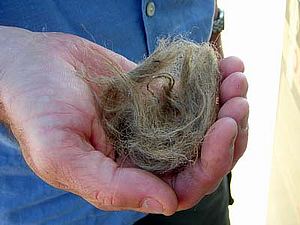
Everyone knows what tinder is. It’s anything that burns if a spark lands on it – dryer lint, dry grass, whatever. Finding dry tinder is another article unto itself, and there are lots of places to do so, but success depends so much on what terrain you’re in that it’s not worth talking about here. What is worth talking about is a lightweight, portable substitute: oakum.
Oakum is made from jute fibers, the same stuff gunnysacks are made of. It is normally pounded into the seams of a wooden boat as a sort of a primitive caulking. A little bit of oakum is easily fluffed into a small nest, which can accept your char cloth once it carries a spark. It’s available on-line in many places, and a pound will cost you about $7.00 and will last years.
Technique
It’s pretty simple, actually. First, make sure your tinder is prepared and ready to accept your char cloth. Make a nest as shown, and put it where you can reach it easily. Of course, your fire is already prepared with kindling and fuel, and ready to accept your burning tinder.
Now place a small piece of char cloth on the top of the flint as shown. The goal is to shave off a very small strip of metal that will burn and land on the char cloth. Striking down at about a 30-degree angle should create a spark or two, which will cause the cloth to glow red where they land. This often happens on the edge of the cloth, and is hard to see in bright sunlight. If a spark lands on the char cloth, wait and blow gently on it until you see either a glowing crescent or nothing. If nothing, go back to striking.
If you do have a glowing piece of char cloth, great! Fold it onto itself and blow gently to encourage the spark to spread. Here’s the wonderful thing about starting a fire this way – the best time to do it is in the wind, where matches are blown out quickly. In fact, the stronger the wind, the faster your char will be consumed. Place the glowing char into the prepared tinder nest and carefully fold it in on itself. Remember, you still need oxygen in there.
Blowing gently will cause you to see wisps of smoke coming from the bundle. Perfect. Just keep blowing, and pretty soon – POOF! You’ll be ready to start a fire.
With practice, you will be able to start fires consistently and often faster than with conventional methods, especially in adverse conditions. If you have any questions, feel free to comment, and I’ll answer as best I can.
Respectfully submitted,
Canoelover


